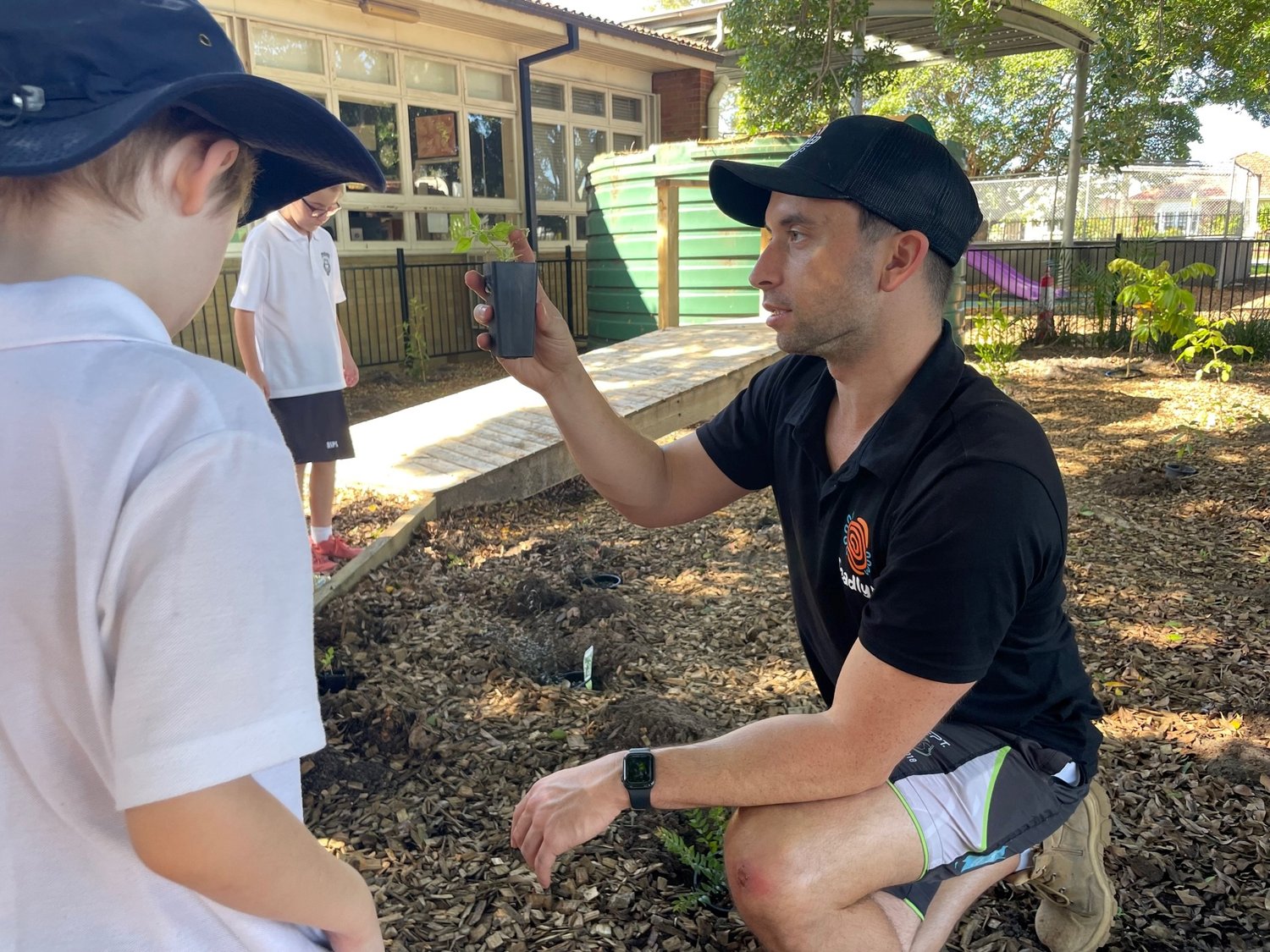When we think of plants and gardens, they’re often associated with hobbies for older people, or as pretty things to just look at or smell (or maybe these were just my thoughts in primary & high school). But our native plants here in Australia offer us so many things that the average Australian would be completely unaware of. Whether it’s a school or a corporate workplace, we can learn about our native bush tucker, use plants for a variety of purposes, and get our hands dirty (in a good way) to create a garden space. With Spring upon us it’s time to make plants and gardens a fun and interactive learning resource!
Learning about native plants and their cultural uses is an essential and now mandatory component of both the primary and secondary science, geography & PDHPE curriculums. To optimise the learning opportunities for both kids and adults, we need to know how bush tucker gardens provide a range of health benefits through the mere creation of a garden space and more importantly by having more green space around us.
Over the last 20 years, the Royal Botanic Gardens Community Greening team have analysed the health benefits of having a garden space. Their data and feedback from their community & school groups who’ve created garden spaces have said that they positively improve:
-
mental and physical health - via physically creating and maintaining the garden (and getting outdoors).
-
Building cohesion between participants and the area/school – when individuals are personally involved in making a garden, it creates a sense of ownership, belonging and accountability for it. Plus gets teamwork and communication flowing.
-
Healthy lifestyles – the more things we can grow and eat from Mother Earth, the better this will be for our personal health, but also the health of the environment (we’ll go into the health benefits of bush tucker below).
Yet, the major risk factors we witness in our youth now through either teaching experiences and our cultural education programs, is poor mental health, lack of access to green space, getting outside and social anxiety. And we know that the overuse of technology affects a majority of these reasons. Creating a garden space in your school or organisation should be viewed as a method for solving this growing issue within our youth, not just for the purpose of ticking off some learning outcomes or KPI’s.
Why bush tucker is the solution
Whenever you hear about or mention the term ‘bush tucker’ people are instantly intrigued or excited. Why is that? What we consider bush tucker has evolved significantly over the past 10-20 years. It’s more than the old-school view of ‘bush tucker’ where people would often ask, “oh isn’t it just witchetty grubs and kangaroo?”
Seeing bush tucker and being able to pick something raw off a plant and eat it there and then is something everyone across Australia (and the world) should be accustomed to. But unfortunately, this isn’t the case. The significant lack of cultural education relating to bush tucker over time, has led to many generations either not knowing anything about it, or having a very simplistic view of it.
Many fear that eating something from a native plant could kill us, which in this country, it isn’t too farfetched given the things that sliver or crawl around the bush.
Fortunately, the upside of growing, finding and eating bush tucker far outweighs the negative misconceptions associated with it. Native Australian plants and bush tucker have a range of health benefits for us and the environment including:
-
Higher vitamin C
-
Higher antioxidants
-
Low or no fat (in meats)
-
Low amounts of water or fertiliser to maintain (compared to introduced fruit plants)
-
Are suited to the Australian climates and soil (which means they’re good for the environment)
-
If it’s poisonous, it’ll taste bad. So spit it out!
The health benefits alone should be the driving reason to create a bush tucker garden in your school because the reality is that it comes back to the intrigue and excitement we can get from students (and adults) about the possibility of something we created that then grows food we can literally see and eat.
But the most important reason for creating a bush tucker garden is to connect to Aboriginal culture. Learning about and connecting to Country, the flora and fauna is at the heart of our culture. Creating a space that encompasses native plants is the first step to connecting anyone with Aboriginal culture, our lore and our Dreaming. Bush tucker and native plants attract native wildlife in the form of birds, bees or larger native animals which is important for maintaining healthy ecosystems in our environments. Bush tucker gardens also connect us to the ancient knowledge of the First Australians, showing us how to care for Country and appreciate the sacredness and extensive uses of native plants. While colonisation has done its part in undoing many of our cultural practices, we all have a responsibility to learn more about our native flora and dismantle simplistic colonial views of native Australian plants. Bush tucker gardens transmit us through time and allow us to engage with cultural practices that this land has observed for thousands of years.
But how do I create a bush tucker garden space?
Creating a bush tucker garden may seem like a huge, high maintenance and ever-lasting headache of a task…but it doesn’t have to be.
We are often asked to help create bush tucker garden spaces, so we guide decisions about their formation using this checklist:
-
Why are you creating the space? If it’s for any of the above reasons, AMAZING!
-
Are you wanting to create a garden from the ground or a raised garden? If you don’t have any room, are legally unable to, or you’re in a concrete jungle – we recommend a raised garden bed solution.
-
Will it be a plant-only garden or are you wanting to create a deadly cultural learning space that includes forms of Aboriginal art, Acknowledgment of Country plaques so visitors know what land they’re on or building a yarning circle or dance space within it.
-
What is your budget? This is purely just to know what we can do with your available resources.Native plants & materials cost money, so do consider this.
-
What types of plants do you want? Just edible bush tucker plants or do you want a mix of plants used for food, medicine, tools and materials by various mobs?
But most of all, you need to have a plan of who will be involved in creating and then maintaining the garden. This means making sure there’s a group or multiple groups of students and staff creating the initial space, then planning out how the garden will be embedded into school programs and classroom curriculums. We suggest that the garden is the responsibility of a particular year group to look after (usually whichever year group is focusing on native plants and their cultural uses in the curriculum that year) which is then passed onto the next cohort the year after and so on. The garden should never fall onto a staff member, general assistant or parents/community to maintain.
Whenever we create garden spaces with schools or workplaces, its all about teaching everyone how to create the garden from scratch, how to plant and look after the plants, plus what each plant is and their Aboriginal cultural uses. We do this in a fun and interactive environment to promote teamwork, cohesion and to give everyone involved a sense of ownership for creating their space.
But what happens if those who created the garden or those with the plant knowledge move on?
This would be up there as the number one reason why so many gardens have failed or are totally forgotten about. There have been many instances where we have seen amazing native plant gardens and spaces sitting there like a library, not being utilised, simply due to the person who originally created it or was the only person who knew anything about it had moved on. The way we have solved this issue is by installing our native plant signage, equipped with the name of the plant, Aboriginal cultural uses of it, plus a QR code to take users to more information about how and where it grows.
How creating your bush tucker garden helps more than just students & staff
The impact of creating native plant gardens and cultural learning spaces extends far beyond just those students or staff who are involved in creating it. By using Aboriginal businesses throughout the process for creating and/or maintaining, it can strengthen connections with community, supports the growth and development of Aboriginal businesses in this sector, and ensures that your project is authentic from start to finish. We always use Aboriginal-owned and operated plant suppliers for all of our gardens such as Bush to Bowl. Ensure to do your own desktop research or have a look on socials wherever you’re located as there are plenty of mobs out there entering this space of native plants.
Here at Deadly Ed, we’re committed to and excited about helping any school and workplace create bush tucker gardens, as it connects us and you to so many positive personal and community benefits. We can make a bush tucker garden a useful learning resource that gets people outside and learning to grow native foods in a fun and engaging way. More importantly, by using Aboriginal businesses for your native garden projects, you can ensure you’re getting the right information from the right people, supporting our mob, whilst embedding cultural knowledge of native plants into the learning environment for years to come.
If you want any assistance with your bush tucker garden project, be sure to contact us





